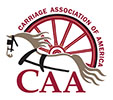Hooper & Co.
London, England
Circa 1890
Type:
This style of phaeton is patterned after a pony phaeton made for King George IV by the London builder William Cook in 1824. As Prince Regent during the reign of his father, King George III, he became fond of driving, using a high-perch phaeton that was fashionable among young bloods during the closing years of the 18th century. In later years, as he grew portly and less active, he needed a carriage that was easier of access than the high-perch phaeton. A print showing the King driving his pony phaeton was published, and the type became an accepted pattern. Similar phaetons with a high, sweeping dash became popular for driving in the park by ladies. They were then known as “park phaetons,” but “George IV phaeton” was the more usual term in the U.S. This example by the long-established and highly-regarded firm of Hooper & Co. has grained hide and Bedford cord trim, and was almost certainly made for an elderly gentleman.
Provenance:
The carriage is thought to have been built about 1890. In the 1920s it was acquired by Mr. H. John Colebrook of Fulmer Hall, Buckinghamshire, England. It was sold by auction with several other of his carriages in 1966 and bought by Mr. George Mossman, from whom Mr. Seabrook bought it at a later date.
Builder:
The firm of Hooper & Co. was founded about 1850 by George Hooper, a former partner in the noted firm of Hobson & Co. of Long Acre, London. George Hooper was later a member of the firm of Adams & Hooper of 28 Haymarket, and Hooper & Co. was the successor to this firm at the same address. George Hooper’s sons, George N. and William, continued the firm at the same address until 1870. About 1899, the firm opened a show room at 54 St. James Street with a factory in King’s Road, Chelsea. In 1902 they built the State Landau for King Edward VII, and this is still an important carriage in the Royal stables.

